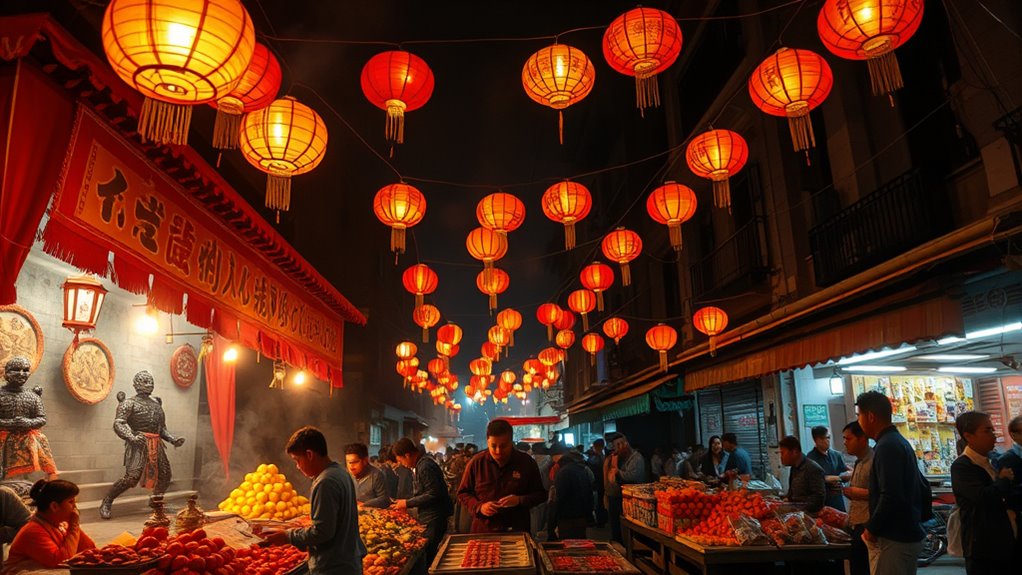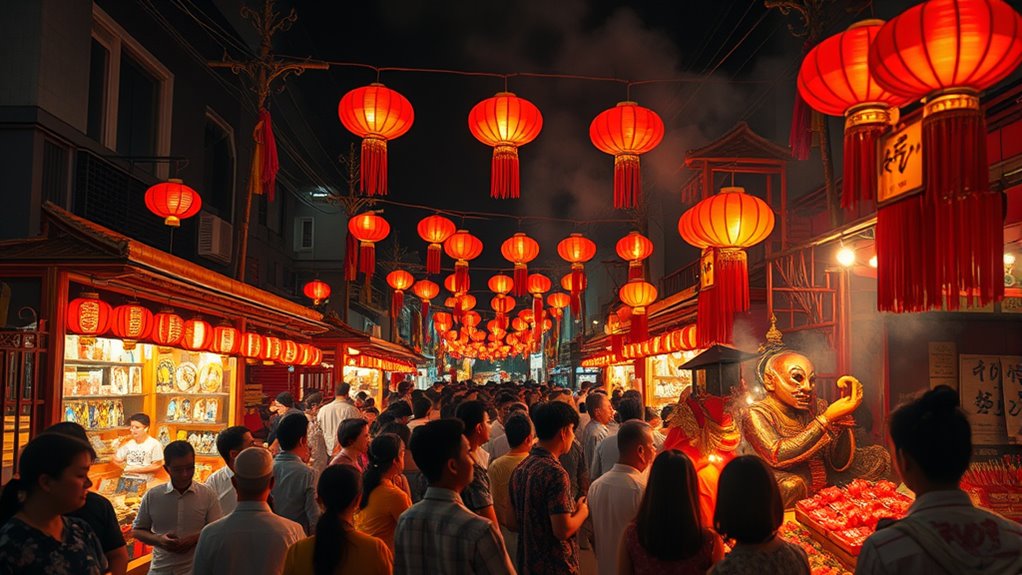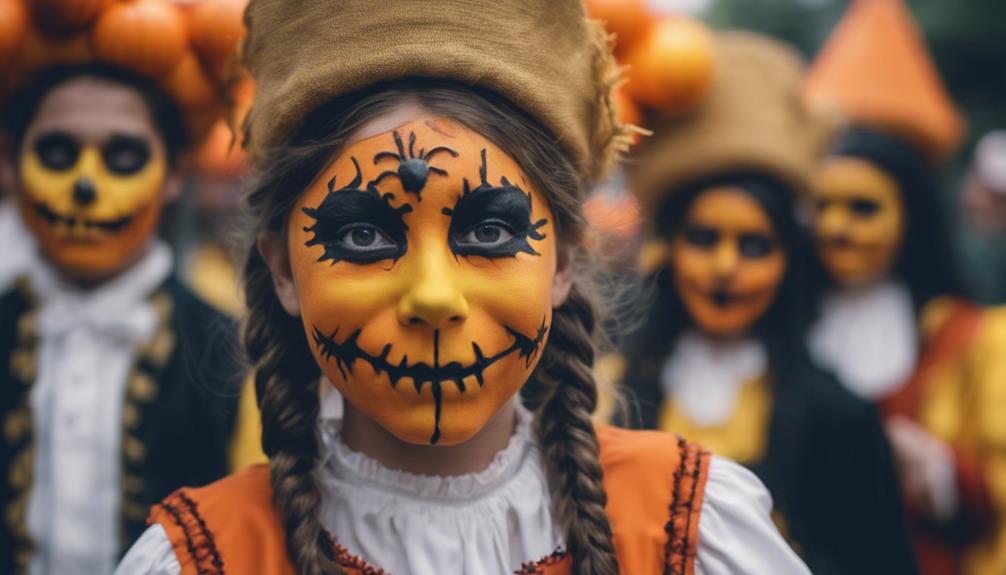During the Hungry Ghost Festival in Asia, you see communities honoring restless spirits through elaborate rituals, offerings, and lively celebrations. People light incense, burn joss paper, and release floating lanterns to show respect and guarantee peace for the spirits. Streets and temples are decorated with colorful symbols, creating a vibrant atmosphere of tradition and spiritual harmony. To understand how this festival strengthens cultural bonds and deepens ancestral ties, keep exploring further details.
Key Takeaways
- The Hungry Ghost Festival is a traditional Asian celebration honoring and appeasing restless spirits of the deceased.
- It features elaborate rituals such as offerings, incense burning, and releasing floating lanterns.
- The festival is marked by vibrant decorations, community participation, and cultural symbols like paper lanterns.
- It emphasizes filial piety, ancestor worship, and maintaining harmony between the living and spirit worlds.
- The event reinforces social cohesion and cultural heritage across various Asian countries like China, Singapore, Malaysia, and Taiwan.

Have you ever wondered why communities across Asia hold elaborate rituals during certain times of the year? One of the most significant occasions is the Hungry Ghost Festival, a time when people honor those who have passed on and seek to appease restless spirits. During this festival, you’ll notice that ancestor worship plays a central role. Families gather to prepare offerings—food, incense, and paper goods—that are meant to nourish and comfort the spirits of their ancestors. These traditional rituals are deeply rooted in cultural beliefs that the spirits of the deceased continue to influence the living world. By conducting these ceremonies, communities aim to show respect, maintain familial bonds, and ensure that spirits are not forgotten or angered.
As you observe these rituals, you’ll see that they often involve elaborate ceremonies performed at temples, homes, or even open spaces. People light incense sticks, bow, and make offerings of fruits, sweets, and rice to invite ancestral spirits and ancestors. These acts of reverence are not just about remembering loved ones; they’re about maintaining a spiritual connection that transcends death. Through ancestor worship, families demonstrate their filial piety and uphold their cultural heritage, ensuring that the memory of their ancestors remains alive and honored. Traditional rituals during the festival serve as a tangible way to express gratitude and seek protection from malevolent spirits that are believed to roam freely during this time. Additionally, the belief in spirit world influence underscores the importance of these rituals in maintaining harmony between the two realms.
During the festival, you’ll also notice that streets and temples are decorated with paper lanterns and joss sticks, creating a vibrant atmosphere. Rituals often extend to releasing floating lanterns or burning joss paper to send offerings to the spirit world. These practices are believed to help spirits find their way and to bring good fortune to the living. Many communities also perform communal prayers, chanting, and dancing to ward off evil and attract blessings. These activities are more than just cultural displays; they are powerful expressions of faith and community cohesion, reinforcing the importance of tradition and spiritual harmony.
Ultimately, the Hungry Ghost Festival reminds you of the enduring importance of ancestor worship and traditional rituals in Asian cultures. It’s a time when the living come together to honor their ancestors, seek spiritual protection, and uphold age-old customs. These rituals serve as a bridge between the worlds of the living and the dead, ensuring that respect and reverence continue across generations. For those participating, it’s a profound reminder of the enduring bonds that tie families and communities through faith, tradition, and remembrance.
Frequently Asked Questions
How Do Different Asian Cultures Celebrate the Hungry Ghost Festival?
You see, different Asian cultures celebrate this festival through unique traditions. You might participate in ancestor worship, offering food and burning incense to honor spirits. Cultural performances like dances and opera are common, aimed at entertaining and appeasing the spirits. You could also release paper lanterns or float boats to guide wandering ghosts. These customs help you respect ancestors and guarantee good fortune for the coming year.
Are There Specific Foods Traditionally Eaten During the Festival?
Imagine a tapestry of flavors woven into a ritual. During the festival, you’ll find traditional offerings like rice, fruit, and incense, symbolizing respect and remembrance. You might enjoy symbolic dishes such as rice dumplings and noodles, representing longevity and connection. These foods aren’t just sustenance; they’re a way to honor spirits, making the celebration both a feast and a heartfelt gesture to the unseen.
What Is the Significance of Burning Incense and Joss Paper?
You burn incense and joss paper as part of ancestor veneration, believing these spiritual offerings help communicate with spirits and guide them. The fragrant incense purifies the environment and invites positive energy, while the joss paper symbolizes wealth and respect, providing for ancestors in the afterlife. This act shows reverence, strengthens family bonds, and guarantees that spirits are remembered and honored during important cultural traditions.
How Has the Festival Evolved in Modern Urban Settings?
Like a river that adapts its course, the festival has evolved in urban settings through digital adaptations and new urban rituals. You might see virtual offerings or online prayers, blending tradition with technology. These changes keep the spirit alive amidst city life, making the festival more accessible while maintaining its core significance. You participate in a modern dance of honoring ancestors, ensuring the ancient roots grow strong in contemporary streets.
Are There Any Safety Precautions for Festival Participants?
When attending festivals, you should prioritize festival safety and follow participant precautions to guarantee a safe experience. Always stay aware of your surroundings, avoid overcrowded areas, and keep personal belongings secure. Respect local customs and guidelines, especially during nighttime events. If alcohol is involved, drink responsibly. By staying vigilant and adhering to safety measures, you can enjoy the festival while minimizing risks for yourself and others.
Conclusion
As you step back from the vibrant streets and flickering lanterns of the Hungry Ghost Festival, remember you’re walking through a living tapestry of tradition and belief. It’s like peering into a lantern-lit mirror that reflects centuries of honoring spirits and seeking harmony. This festival reminds you that in Asia’s rich cultural quilt, the boundaries between the seen and unseen blur beautifully, inviting you to embrace the mystery and respect the ghosts that dance in the shadows of history.










